League of Olympic Swim Legends: Janet Evans Tops 400 Free Podium With Norelius, Meyer & Ledecky
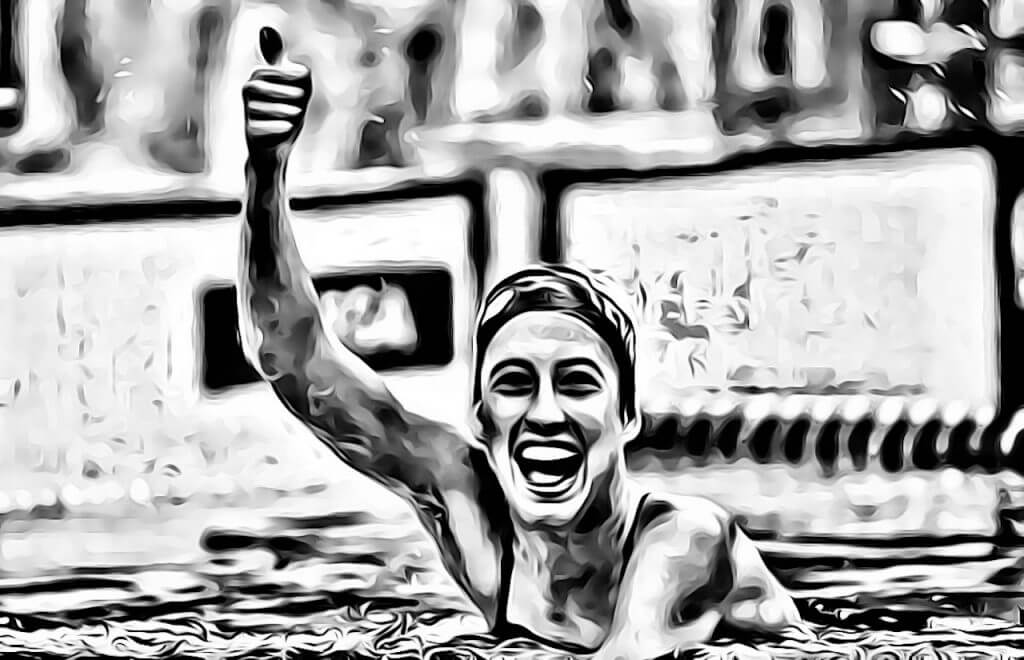
What would have unfolded had Tokyo 2020 gone ahead as planned this week – and where would it all have fit in the thread of Olympic swim legends like Janet Evans, Martha Norelius, Debbie Meyer, Katie Ledecky and Shane Gould? To mark the eight days over which the Tokyo 2020 Olympic Games would have unfolded had the coronavirus pandemic not forced postponement, the team at Swimming World is filling the void with a Virtual Vision Form Guide and League of Olympic Swimming Legends.
Tokyo Vision: Can Katie Ledecky Hold Off Ariarne Titmus in 400 Freestyle Shootout?
Day 2, event 3 – to the heart and Seoul 1988 of the matter…
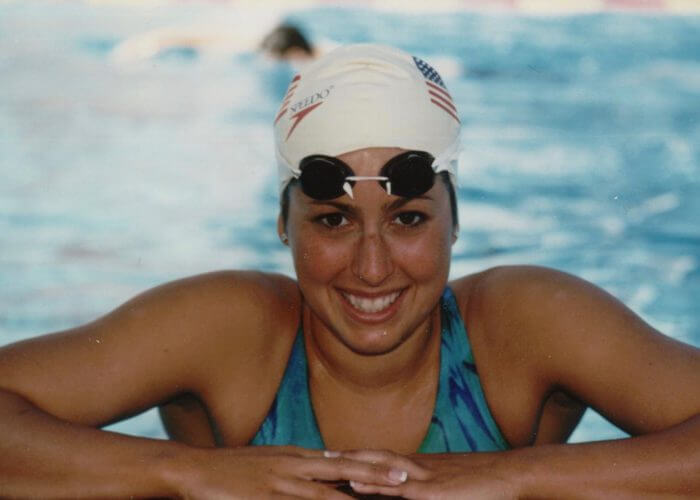
Janet Evans – Photo Courtesy: Bill Collins
Women’s 400m Freestyle
The Podium
- Janet Evans (USA)
- Martha Norelius (USA)
- Debbie Meyer/Katie Ledecky (USA)
The Other Finalists (Listed Alphabetically):
- Shirley Babashoff (USA)
- Shane Gould (AUS)
- Ragnhild Hveger (DEN)
- Laure Manaudou (FRA)
- Our Lane 9* place goes to the other Olympic 400m freestyle champion who once held all world records from 100m to the mile simultaneously and claimed the 1932 crown in World-record time:
- Helene Madison (USA)
All-Time Battle Of Olympic Swim Legends Goes To Janet Evans
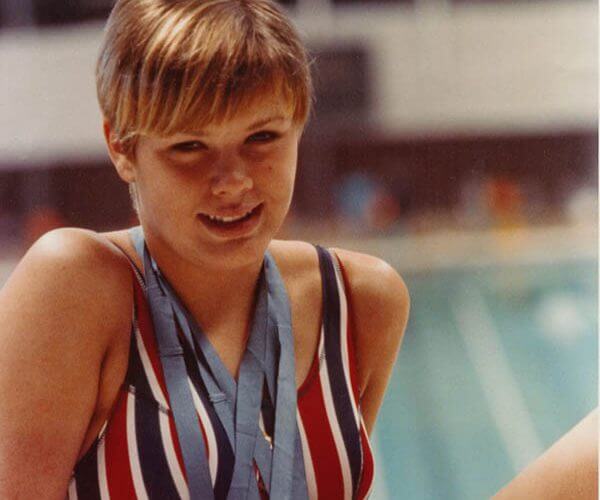
Debbie Meyer with medals Photo Courtesy:
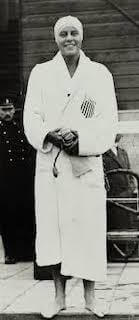
Martha Norelius – Photo Courtesy: ISHOF
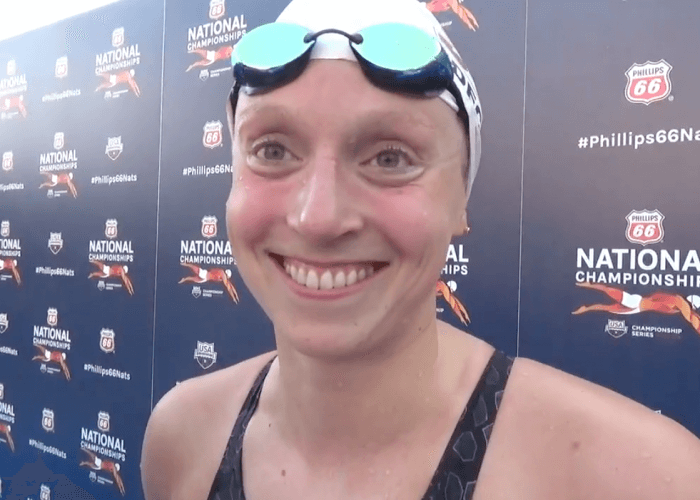
Katie Ledecky – Photo Courtesy: Swimming World
When you are an Olympic champion and held the world record in the event for 18 years, as is the case with the United States’ Janet Evans, it’s not hard to figure how she won Legends gold. Similar to the men’s 100 breaststroke, there could be a change in the future, but the current status of the 400 freestyle presents Evans on top.
Although more dominant in the 800 freestyle and 1500 freestyle, Evans rattled her competition over eight laps. When she won gold in 1988 in Seoul, she posted a time of 4:03.85, that mark lasting until 2006. Simply, Evans was competing in the future, and while she had slipped a bit by the 1992 Olympics in Barcelona, she was still strong enough to win a silver medal in the 400 free.
The silver medal here might be a surprise, except for those with a sensational grip on history. Martha Norelius won back-to-back gold medals for the U.S. in 1924 and 1928 and set four world records during that span. She is followed by a tie for the bronze medal, Americans Debbie Meyer and Katie Ledecky sharing third on the strength of Olympic crowns in 1968 and 2016, respectively. While Meyer set five world records in the 400 free, Ledecky has established three global standards in the event.
By next summer, Ledecky could be found higher on the podium, especially if she repeats as the Olympic champion, and in an expected tussle with Australian youngster Ariarne Titmus.
Our counts per event do not favour short careers of high magnitude – and as such Shane Gould (AUS) does not make our podium but you can read below why she’s a must for our league-of-legends line-ups.
Recalling the unorthodox style of Janet Evans, a wind-milling speedster of distance racing:
Olympic Swim Legends – Our Winner’s Winning Ways:
Janet Evans – First Freestyle Gold
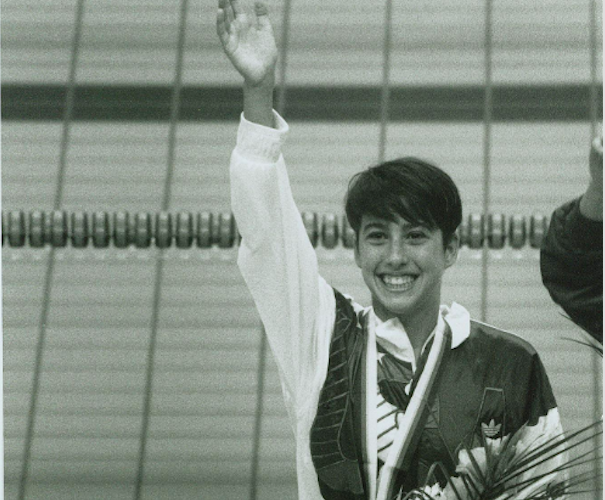
Janet Evans – Photo Courtesy: International Swimming Hall of Fame
1988 Seoul – Women 400m Freestyle: Athletes: 44; Nations: 29
- 4:03.85wr Janet Evans (USA)
- 4:05.95 Heike Friedrich (GDR)
- 4:06.62 Anke Möhring GDR
4:08.16 Tami Bruce (USA)
4:10.64 Janelle Elford (AUS)
4:11.73 Isabelle Arnould BEL
4:13.05 Stephanie Ortwig (FRG)
4:13.92 Natalia Trefilova URS
Date of final: September 22, 1988
Place Janet Evans in a time-warp machine and transport her to Beijing 2008 and you still have a 400m and 800m freestyle gold-medal prospect: her world records over 400m and 1,500m from 1988 were finally surpassed in 2006 and 2007 respectively, while the 800m standard she established in 1989 was still standing as FINA entered its centenary year.
If her records were sensational, they also overshadowed her versatility: at the 1988 Olympic Games, the first of three gold medals came her way in a 400m medley final that she won in 4:37.74.
Capable of swimming all four strokes competently by the time she was five, Evans is the living truth at the heart of the phrase “it’s not the size of the dog in the fight that counts but the size of the fight in the dog”. Teased because of her lack of height and weight as a junior, the student from aptly named El Dorado High School in the town of her birth, Placentia, California, answered back by channelling her competitive nature into training and a stroke rate second to none: she was described as swimming like a “windmill in a hurricane”.
She would later say:
“My straight-arm recovery was natural. I really couldn’t swim it any other way. I think I developed it when I was a kid and I wanted to get down the pool the fastest. I figured the fastest way to get to the other end was to turn my arms over as fast as I could.”
At Fullerton Aquatic Swim Team she was a coaching dream-come-true for Bud McAllister: she trained hard, never complained and focused on improving. At 13 she won her first national junior title, over 1,500m freestyle, and in 1987 she claimed the first of 45 national senior crowns.
That same year, Evans set the first two of seven world records on freestyle, over 800m and 1,500m, but learned to set her standard high when the 8:22.44 in which she consigned Tracey Wickham’s 1978 global mark to history was replaced by an 8:19.53 from Anke Moehring (GDR) less than a month later.
In December, Evans took out another Wickham milestone with a 4:05.45 world record over 400m and the following March, 1988, she hit back over 800m with an 8:17.12.
Evans arrived in Seoul as a favourite to win the Olympic distance freestyle crowns but started her campaign with victory over 400m medley. Three days later, she set a stunning world record of 4:03.85 to win the 400m freestyle but if the end time caused mouths to fall open, it was the way in which Evans set a world record that would last 17 and a half years that was talked about long after the storm had settled down.
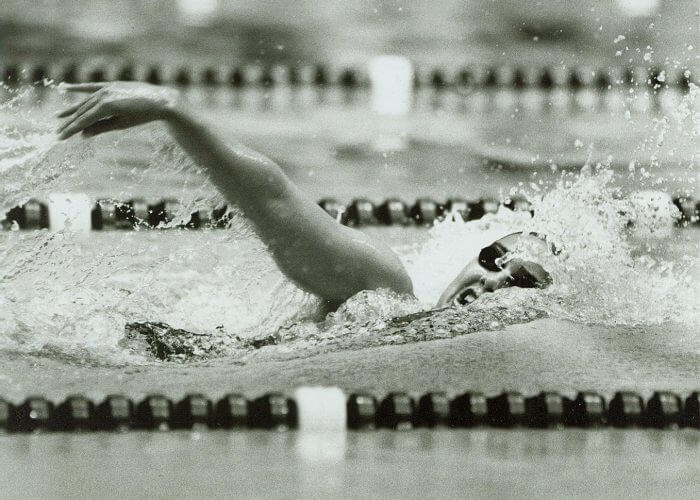
Janet Evans – Photo Courtesy: International Swimming Hall of Fame
Evans led from start to finish, turning in 59.59 and 2:02.49, with Heike Friedrich (GDR) just 0.01sec behind. Friedrich had won all 13 international finals she had raced in since 1985 and was still in contention at 300m, 3:03.40 to 3:04.56. She was also known for her finishing strength. But Evans, more than 20kg lighter than her rival, proceeded to race faster over the homecoming 200m than she had over the first 200m: 2:02.14 and 2:01.71.
On the eve of the Beijing 2008 Olympic Games, no woman had ever swum the last 200m of a 400m race faster, while only one woman, Otylia Jedrzejczak (POL) had ever raced faster than Evans’s last 100m of 1:00.45: the Pole clocked 59.70 chasing Olympic champion Laure Manaudou (FRA) to take the silver medal at the 2007 World Championships.
It was Manaudou, at Tours on May 12, 2006, who finally got past Evans on the clock over 400m, in 4:03.03. Silver and bronze went respectively to Friedrich, in 4:05.94, a European record, and Moehring, on 4:06.62. Evans claimed her third gold medal of the 1988 Games in the 800m.
Four years on heading to Barcelona 1992, former East German Dagmar Hase (GER) clocked 4:12.60 at Olympic trials in May. At the Games two months later, she scorched her lifetime best to prevent Evans from retaining the 400m crown in what was Hase’s first major international 400m. The gap on the clock was 4:07.18 to 4:07.37.
Evans led by a bodylength at 300m but Hase stormed back in the closing 20m to take the crown from the defending champion. She then emerged to make a controversial dedication: her medal was in honour of former East German teammate Astrid Strauss, the 1988 silver medal winner for the GDR behind Evans. On June 1, 1992 at the German national championships, Strauss, who was to have raced in Barcelona, had become the first swimmer ever to have raced for the GDR to test positive in official anti-doping tests beyond East German borders. The substance was testosterone and the suspension 18 months.
Another Great 400m Freestyle Race In History
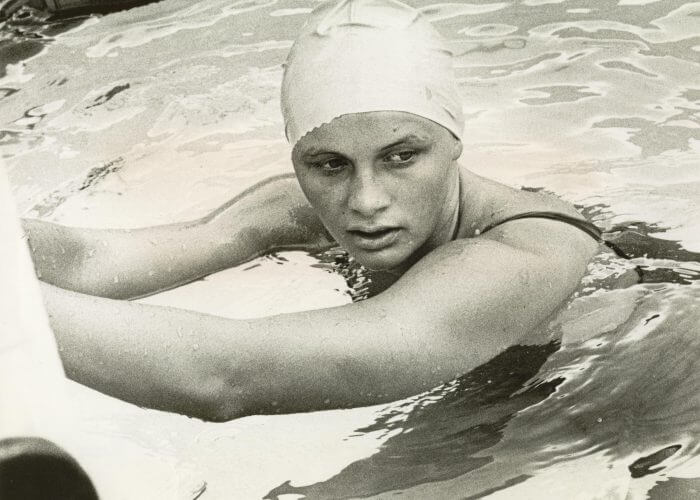
Shane Gould – Photo Courtesy: Kevin Berry/Swimming World Archive
1972 Munich – Women 400m Freestyle: Athletes: 29 Nations: 17
- 4:19.04wr Shane Gould AUS
- 4:22.44 Novella Calligaris ITA
- 4:23.11 Gudrun Wegner GDR
4:23.59 Shirley Babashoff USA
4:24.07 Jenny Wylie USA
4:24.22 Keena Rothhammer USA
4:29.70 Hansje Bunschoten NED
4:31.51 Anke Rijnders NED
Date of final: August 30, 1972
Our legends line-ups – which consider each event in isolation and rely on points accrued over a number of years – do not take account of shooting stars, though our summary of the exercise will.
As such, Shane Gould, one of the brightest stars in swimming’s Milky Way, is under-scored by her short time spent bating rivals and setting records, including all of them from 100m to 1500m, at one point all of the standards for those distances held together. So for now, we celebrate Gould be recalling how bright her star shone with this recollection:
On February 3, 1971, a 14-year-old shooting star called Shane Gould began her ascendancy across the Southern skies of Australia with an 8:58.1 world record time in the 800m freestyle. It was the first of 11 global standards that she would set over a period of two years and eight days that marked the greatest whirlwind career in swimming history and one topped by five individual medals at the Olympic Games in Munich, 1972.
Gould remains the only woman to have achieved that five-solo medal score in swimming. Without relays (she raced the 4x100m free, the Aussies home last in the final). Had she been born of Stars and Stripes, she would probably have matched Mark Spitz‘s seven.
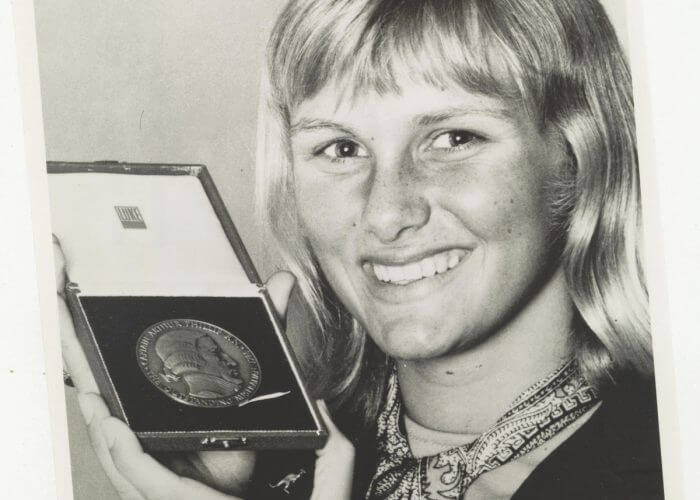
Shane Gould – a Living National Treasure in Australia – Photo Courtesy: Swimming World Archives
By the time she arrived in Germany, Gould, coached by Forbes and Ursula Carlile (chaperone at Munich 1972) at Ryde in Sydney, had matched American Helene Madison’s 1931 feat of holding the world record in all metric distances from 100m to 1,500m (Madison’s were not all official world records but the best at all the distances swum she was for a time).
By the time Gould lined up for the final of the 400m freestyle, she had already claimed gold in the 200m medley in a world record and bronze in the 100m freestyle.
In the 400m qualifying round, the Olympic record fell in the first and fourth heats, first to Jenny Wylie (USA) in 4:27.53, then to Novella Calligaris (ITA) in 4:24.14. Gould progressed in fifth, on 4:28.46, and Shirley Babashoff (USA), who had taken silver ahead of the Australian in the 100m, was last through, on 4:31.98.
In the final, Gould roared away from her rivals from the outset, turning first in 1:01.50, before settling on three 1:06s over the next 400m: 2:07.04 and 3:13.55, the title sealed in 4:19.04, a World record and the first sub-4:20 effort.
The gap to those chasing was big, silver going to Calligaris, on 4:22.44, a European record, and bronze to Gudrun Wegner (GDR) ahead of Babashoff, while Keena Rothhammer (USA), who had tried to stay as close to Gould as she could until halfway, with splits of 1:02.57 and 2:08.97, found that pace too hard and faded to sixth.
Two days later, Gould claimed the 200m freestyle title in a world record pf 2:03.56, and two days after that, her energy pack running low, Gould concluded her programme with a silver in the 800m behind Rothhammer.
The Australian had raced 4.2km in 12 races in a week. Gould left Munich with a new name – “Goldfisch” – and as the youngest woman swimmer ever to have won an Olympic gold medal, at 15 years and 9 months. The following year, at 16, she retired from the pool.
Mike Wenden, the 1968 100m and 200m Olympic champion for Australia and captain of the 1972 squad would later say:
“Shane was like a high-decibel concert that had such an impact it left your ears ringing. But it left you still humming the tunes long after it came to an end.”
See if you can spot the swimmer with the “modern” approach, attack and technique:




PABLO!!